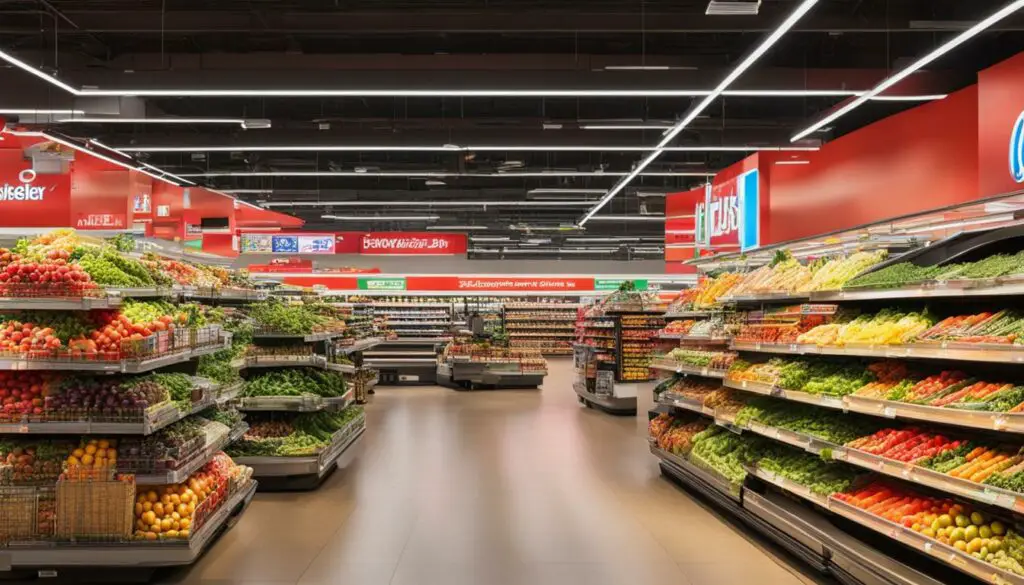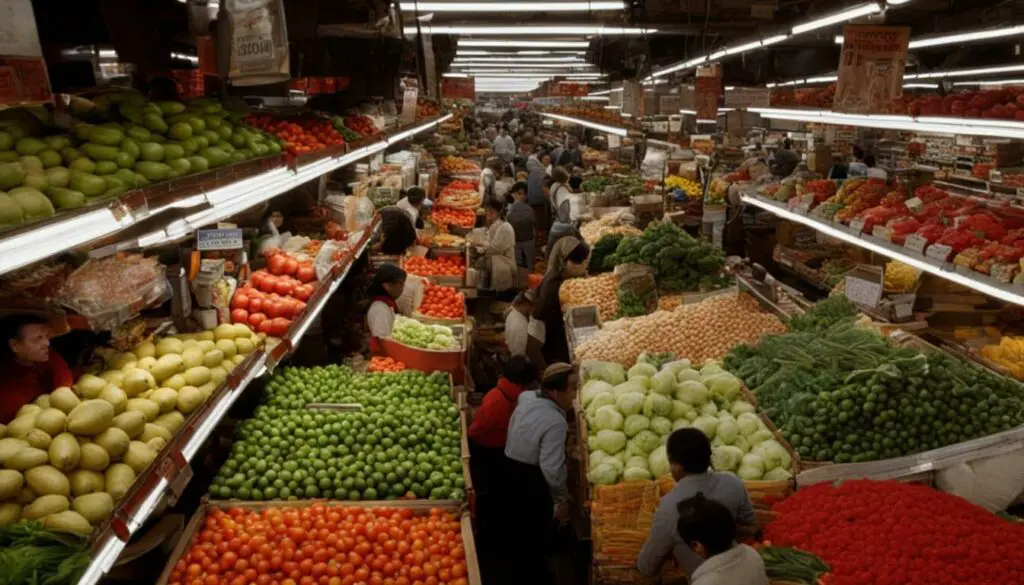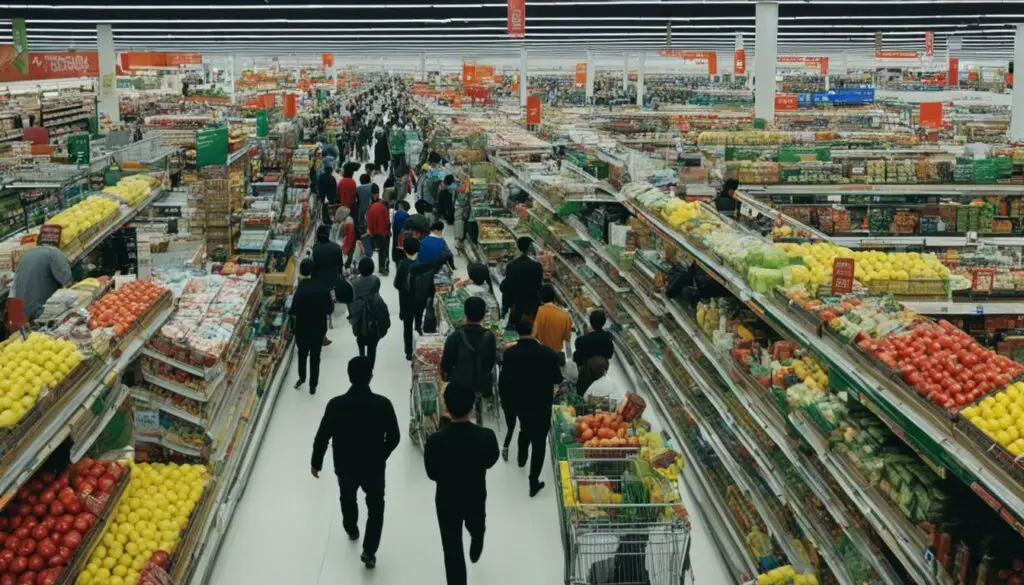Originally posted on December 24, 2023 @ 5:39 am
Welcome to a journey through the rich history of grocery stores. Have you ever wondered what the first grocery store was? How did the concept of supermarkets come into existence? Join us as we delve into the fascinating origins and evolution of grocery stores, from humble mom-and-pop shops to the modern-day supermarket chains that have become an essential part of our lives.
Table of Contents
Key Takeaways:
- The first grocery store that resembled a modern supermarket was King Kullen, opened in New York City in 1930.
- Supermarkets introduced self-service, separate product departments, discount pricing, and volume selling, revolutionizing the grocery industry.
- Early grocery stores operated on a counter-service model, with limited product variety and negotiation-based pricing.
- Supermarkets evolved to offer a wide range of products, incorporating innovations like in-store displays, advertising, and longer shopping hours.
- The rise of supermarket chains led to the decline of smaller independent grocery stores.
Origins of Grocery Stores

Prior to the establishment of supermarkets, grocery shopping was a different experience. Small corner grocery stores, or mom-and-pop shops, were the primary places where people purchased food and household items. These stores operated on a “counter service” model, where customers would wait in front of the counter while a clerk fetched the requested items from behind the counter. Purchases were often negotiated, and prices were not clearly marked. This model was labor-intensive, time-consuming, and limited in terms of product variety.
The early grocery stores were intimate, community-oriented establishments where customers had personal interactions with the shopkeepers. These stores relied on word-of-mouth recommendations and customized service to build relationships with their customers. While the experience was more personal, it lacked the efficiency and convenience that supermarkets would later offer.
Small Mom-and-Pop Shops
The small mom-and-pop shops were often family-owned businesses passed down through generations. These shops catered to the immediate needs of the local neighborhood, offering essential items like bread, milk, and canned goods. The shopkeepers had intimate knowledge of their customers’ preferences and would often recommend products based on their individual needs.
However, the limited product variety and the necessity to wait for the clerk to retrieve the items behind the counter made grocery shopping a time-consuming process. Prices were subject to negotiation, and there was little transparency regarding the cost of products. This lack of clarity often led to customers feeling like they were being overcharged.
“I remember going to the corner grocery store as a child. The shopkeeper knew our family and always gave us extra treats. It was a personalized experience, but we had to wait for everything behind the counter. It could be frustrating at times.” – Evelyn Davis, 78
In addition to the limited variety and negotiation-based pricing, the small mom-and-pop shops faced challenges in maintaining consistent quality. With no centralized supply chain or quality control measures, the freshness and quality of products varied from store to store. This lack of standardization further emphasized the need for a more modern retail model.
Evolution of Grocery Stores

The introduction of supermarkets like King Kullen revolutionized the grocery industry. These early supermarkets offered a wide range of products, with separate departments for different categories such as fresh meat, produce, and dairy. They also implemented self-service, allowing customers to browse and select items themselves. This model significantly reduced labor costs and increased efficiency. Supermarkets adopted innovations like in-shop displays, advertising, and longer shopping hours, making grocery shopping more convenient for consumers.
With the evolution of grocery stores, the shopping experience underwent a major transformation. Gone were the days of waiting in line at a counter and negotiating prices. Customers now had the freedom to explore various product options, compare prices, and make their own choices. The introduction of self-service not only saved time but also empowered consumers in their shopping decisions.
In-shop displays became a common sight in supermarkets, attracting shoppers with eye-catching advertisements and enticing product arrangements. Supermarkets adopted a new level of sophistication in their merchandising techniques, creating visually appealing displays that showcased product offerings and encouraged impulse buying. Longer shopping hours allowed consumers to shop at their convenience, fitting grocery shopping into their busy schedules.
The rise of supermarkets also had a profound impact on the grocery industry as a whole. Smaller mom-and-pop grocery stores faced intense competition from supermarkets, as they struggled to match the convenience, variety, and pricing offered by these larger stores. Many independent grocery stores ultimately closed down or had to adapt to survive in the changing landscape of the industry.
“Supermarkets fundamentally changed the way people shopped for groceries. The introduction of self-service, in-shop displays, and longer shopping hours marked a significant shift in the grocery industry, benefiting both retailers and consumers alike.”
In summary, the evolution of grocery stores brought about by the introduction of supermarkets like King Kullen revolutionized the industry. This shift in retail format not only improved efficiency and reduced costs but also provided consumers with greater convenience, variety, and control over their shopping experience. The impact of these early supermarkets continues to shape the grocery industry today.
Rise of Supermarkets

As the concept of supermarkets gained popularity, grocery chains started to emerge. These supermarket chains were supplied by distribution centers and offered products at lower prices through economies of scale. Supermarkets began to expand their offerings beyond just food, selling household items, electronics, and other non-food products.
The growth of supermarkets and chain stores led to the decline of smaller independent grocery stores. Consumers found the convenience and affordability of supermarkets more appealing, leading to a shift in shopping habits. The rise of supermarket chains transformed the grocery industry, revolutionizing the way people shopped for everyday essentials.
Take a look at the table below to see how supermarket chains became dominant players in the grocery market:
| Year | Supermarket Chain | Number of Stores | Market Share |
|---|---|---|---|
| 1950 | Kroger | 300 | 10% |
| 1960 | Safeway | 700 | 15% |
| 1970 | Kmart | 1,200 | 20% |
| 1980 | Walmart | 2,500 | 30% |
Source: Grocery Retailers Association
The table demonstrates the rapid growth of supermarket chains over the years, with major players like Kroger, Safeway, Kmart, and Walmart dominating the industry. These chains offered consumers a wide range of products, competitive pricing, and a convenient one-stop shopping experience.
With the rise of supermarket chains, the grocery industry entered a new era of mass retail. These chains became anchors of shopping centers and played a vital role in shaping the modern retail landscape.
Impact on Shopping Experience

Supermarkets have revolutionized the shopping experience, providing convenience, a wide range of merchandise, and an enjoyable atmosphere for customers. With their vast selection of products and competitive prices, supermarkets have become the preferred destination for grocery shopping.
One of the key advantages of shopping at a supermarket is the convenience it offers. Supermarkets provide a one-stop solution for all household needs, allowing customers to find everything they need under one roof. From fresh produce to dairy products, household essentials to personal care items, supermarkets offer a diverse range of merchandise to cater to different tastes and preferences.
In addition to a varied range of products, supermarkets also prioritize convenience in terms of accessibility. Most supermarkets provide ample parking spaces, making it easier for customers to visit and shop without the hassle of searching for a parking spot. Moreover, supermarkets often have extended opening hours, allowing shoppers to visit at their convenience, even outside regular working hours.
The shopping experience in supermarkets is also enhanced by the use of shopping carts and self-service checkouts. Shopping carts make it effortless for customers to navigate through the store and carry their purchases, eliminating the need to carry heavy shopping bags. Self-service checkouts offer a quick and efficient way for customers to pay for their items, reducing waiting times in queues.
To enhance the shopping experience further, supermarkets invest in advertising and elaborate in-store displays. Eye-catching displays and well-designed layouts create an inviting atmosphere that entices customers and encourages them to explore the store. By strategically positioning products and showcasing special offers, supermarkets drive sales and make shopping more engaging and enjoyable for customers.
In summary, the convenience, wide range of merchandise, and overall shopping experience offered by supermarkets have made them a preferred choice among consumers. From the convenience of one-stop shopping to the availability of various products and attractive displays, supermarkets continue to provide an enjoyable and efficient shopping experience for customers.
Introduction of Hypermarkets and Supercenters

In addition to supermarkets, the concept of hypermarkets and supercenters emerged to meet the evolving needs of consumers. Hypermarkets are big-box markets that combine the offerings of a full-service supermarket with a department store, providing customers with an extensive range of products all under one roof.
Hypermarkets go beyond traditional supermarkets by offering a wide variety of non-food items such as clothing, electronics, household appliances, and more. This integration of a supermarket and a department store creates a unique shopping experience, where customers can conveniently find everything they need in one place.
Supercenters, on the other hand, are similar to hypermarkets but typically associated with specific retail chains. These supercenters also feature a large supermarket combined with a department store, providing customers with an even broader selection of products and services.
Hypermarkets and supercenters have become popular destinations for one-stop shopping, catering to the growing demand for convenience and variety. These stores often incorporate additional services such as banking facilities, cafes, pharmacies, and more, further enhancing the shopping experience for customers.
“Hypermarkets and supercenters revolutionized the retail industry by offering a comprehensive range of products, convenience, and additional services, all in one convenient location.”
Let’s take a look at how hypermarkets and supercenters compare:
| Hypermarkets | Supercenters |
|---|---|
| Combination of a supermarket and a department store | Combination of a supermarket and a department store |
| Offers a wide range of products, including non-food items | Offers a wide range of products, including non-food items |
| Provides additional services such as banking, cafes, and pharmacies | Provides additional services such as banking, cafes, and pharmacies |
| Aims to provide a comprehensive shopping experience | Aims to provide a comprehensive shopping experience |
Benefits of Hypermarkets and Supercenters
- Convenience: Customers can find a wide variety of products in one location, saving time and effort.
- Wide Selection: Hypermarkets and supercenters offer a diverse range of products, including groceries, household items, electronics, clothing, and more.
- Additional Services: These stores often provide banking services, cafes, pharmacies, and other amenities, enhancing the overall shopping experience.
- Competitive Pricing: The combination of large-scale buying power and a comprehensive product range allows hypermarkets and supercenters to offer competitive prices to customers.
With their convenient and comprehensive approach to shopping, hypermarkets and supercenters have become popular destinations for consumers looking for a one-stop shopping experience. These stores continue to evolve and adapt to meet the ever-changing demands of the modern consumer.
The Grocery Industry Today
The grocery industry has undergone significant changes in recent years to keep up with evolving consumer preferences and technological advancements. One of the key trends that has gained traction is the rise of online grocery shopping and delivery services. With the convenience of ordering groceries from the comfort of their homes, customers can now avoid the hassles of crowded stores and long checkout lines.
In response to the growing demand for healthier and specialty products, grocery stores have also expanded their offerings. Many stores now emphasize the availability of organic produce, gluten-free options, and other health-conscious products. This shift reflects the increasing awareness and importance of nutrition and wellness among consumers.
An important trend that has emerged in the grocery industry is the emphasis on sustainability and ethical sourcing. Consumers are now more conscious of environmental issues and are actively seeking out brands and products that align with their values. Grocery stores have responded by partnering with local farmers, implementing eco-friendly packaging, and promoting sustainable practices throughout the supply chain.
“Consumers today are looking for more than just products; they want to support brands that prioritize sustainability and ethical values. Grocery stores play a crucial role in meeting these demands, and it’s important for businesses to adapt and stay competitive in this evolving landscape.” – Jane Adams, Grocery Industry Expert
The current state of the grocery industry is shaped by these market trends, as well as by advancements in technology. In addition to online shopping, grocery retailers are exploring innovations such as self-checkout systems, mobile payment options, and personalized shopping experiences. These efforts aim to optimize the customer journey and provide a seamless and convenient shopping experience.
Overall, the grocery industry continues to evolve and adapt to changing consumer needs. With the increasing focus on technology, sustainability, and personalized experiences, grocery stores are well-positioned to meet the demands of the modern shopper.
Challenges and Future Outlook
The grocery industry is constantly evolving, facing various challenges that require innovative solutions. Some of the major challenges in the grocery industry include:
- Increasing competition
- Rising costs
- Changing consumer behaviors
To overcome these challenges, traditional brick-and-mortar grocery stores must adapt to stay relevant in the digital age. One of the key strategies adopted by many grocery retailers is investing in technology and automation.
By leveraging technology, grocery stores can improve operational efficiency, streamline inventory management, and enhance the overall shopping experience for customers.
Furthermore, the future of grocery stores may involve more personalized and interactive shopping experiences. With the rise of artificial intelligence and data analytics, retailers can gain insights into individual customer preferences and offer tailored recommendations that cater to their specific needs.
Digital integration will play a crucial role in the future of grocery stores. Online ordering, mobile apps, and digital payment systems will continue to gain popularity, providing customers with convenient and seamless shopping experiences.
Additionally, sustainability will be a key focus in the future of grocery stores. With growing concerns about environmental impact and sustainability, consumers are increasingly seeking out eco-friendly and locally sourced products. Grocery retailers will need to prioritize sustainable practices and offer more environmentally conscious options to meet consumer demands.
Overall, the future of grocery stores holds great potential for innovation and transformation. By embracing technology, personalization, digital integration, and sustainability, grocery retailers can overcome challenges and create a shopping experience that meets the evolving needs of consumers.
| Challenges | Solutions |
|---|---|
| Increasing competition | Innovative marketing strategies and differentiation through unique offerings. |
| Rising costs | Investment in technology and automation to optimize operations and reduce expenses. |
| Changing consumer behaviors | Adaptation to digital trends, personalized experiences, and sustainable practices. |
Conclusion
The history of grocery stores has been a fascinating journey, starting with the establishment of the first supermarket by Michael J. Cullen, King Kullen. Since then, supermarkets have revolutionized the way we shop for groceries, offering self-service, discount pricing, and a vast range of products. This evolution continues to shape the grocery industry, driven by advancements in technology and shifting consumer preferences.
As we look to the future, the grocery industry will face new challenges and opportunities. Competition is on the rise, and the emergence of e-commerce is changing the landscape. However, one thing is clear: the grocery store will always be an essential part of our lives. Despite the convenience of online shopping, people still enjoy the experience of physically browsing through the aisles, selecting fresh produce, and engaging with the different departments.
With technology playing a more significant role, grocery stores will likely focus on personalization and digital integration to enhance the shopping experience. Sustainability and ethical sourcing will also become increasingly important, as consumers demand more environmentally conscious practices from both retailers and suppliers. The future of grocery stores holds exciting possibilities, as they adapt to meet the evolving needs and expectations of shoppers.
FAQ
What was the first grocery store?
The first grocery store that can be considered a true supermarket was King Kullen, opened by Michael J. Cullen in New York City on August 4, 1930.
What is the history of grocery shopping?
Before supermarkets, grocery shopping was primarily done at small corner stores or mom-and-pop shops, operating on a counter service model. Supermarkets revolutionized the industry with self-service, separate product departments, and discount pricing.
How did grocery stores evolve?
Grocery stores evolved by offering a wider range of products, adopting innovations like in-shop displays and advertising, and expanding into non-food items. The emergence of supermarket chains led to the decline of smaller independent stores.
What was the impact on the shopping experience?
Supermarkets transformed the shopping experience by offering a broad selection of goods, lower prices, convenience, ample parking, extended shopping hours, shopping carts, and self-service checkouts.
What are hypermarkets and supercenters?
Hypermarkets and supercenters combine a full-service supermarket with a department store, offering a wider range of products and additional services such as banking and cafes.
What is the current state of the grocery industry?
The grocery industry has evolved with online shopping and delivery services, offering organic and specialty products, and focusing on sustainability and ethical sourcing.
What are the challenges and future outlook for grocery stores?
Grocery stores face challenges from increasing competition, rising costs, and changing consumer behaviors. The future may involve more personalized and interactive shopping experiences, digital integration, and sustainability initiatives.
Are grocery stores still important?
Yes, grocery stores remain an essential part of our lives, providing convenience, affordability, and a wide range of products.
Source Links
- https://en.wikipedia.org/wiki/Supermarket
- https://progressivegrocer.com/progressive-grocer-unveils-retailers-century
- https://en.wikipedia.org/wiki/Delchamps
See also:
Leave a Reply